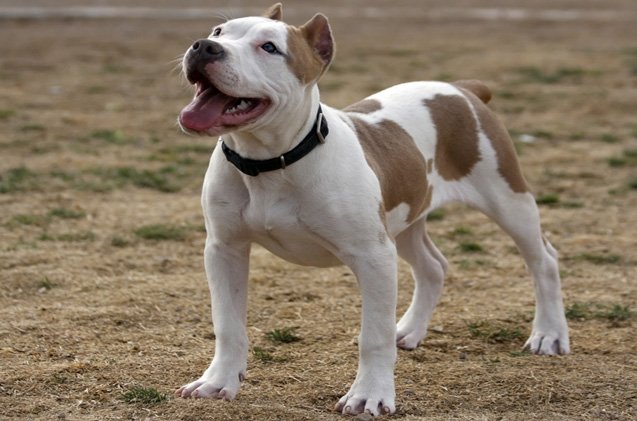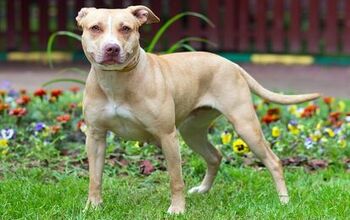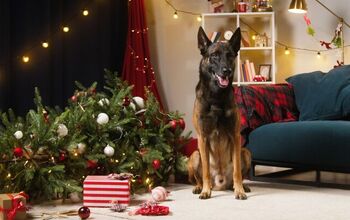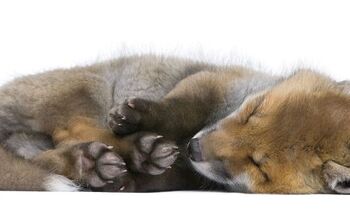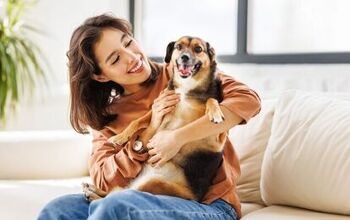Pitbull


About Pitbull
There are few dogs out there more controversial than the Pitbull. Many people believe that the Pitbull is a wonderful family companion while others believe that this hybrid needs to be banned from their communities. The truth is that most Pitbulls, like all other dog breeds, are absolutely reliable pets that are great with kids and love people. Most of their bad reputation can be attributed to bad owners and irresponsible tabloid journalists. It’s certainly not the fault of any Pitbulls out there, who are absolutely wonderful pets as long as they are bred and trained responsibly.
Those who want to have a Pitbull as a member of their families must do their research. Buying a Pitbull on the corner or through the local classifieds ads is a risky situation. It is essential that the buyer talk to the breeder extensively about his experiences and hopes for this hybrid breed. They should ask about health clearances as well as meet both of the parents and any other relatives on the premises. Because of the bad breeders of “Pitbulls”, it is important that the potential buyer be knows everything about the breed before bringing a Pitbull into his household.
Is a Pitbull the right dog to bring into your home? Possibly, but there are many factors to consider. Fortunately, you’ve come to the right place. Keep your eyeballs glued to this page and scroll away to find out if these dogs are the right choice for you!
Pitbulls are reliable pets that are great with kids and love people.
Nobody really knows the exact origin of the Pitbull began. According to most sources, it seems that this dog breed was a result of breeding bulldogs with terriers to create a new hybrid. The goal of the breeders was to produce a dog that would feature the strength of the bully breeds complemented by the perseverance and agility of the terrier. The reason why these particular traits were desirable was that the new hybrid was supposed to excel in bull baiting and bear baiting, two gruesome “sports” that were particularly popular in the 16th century. By the 18th and 19th centuries, a distinct breed of dog was popular in England – the bull-and-terrier. Sadly, the breed was mostly – if not exclusively – used for rat baiting and dog fighting. It is now commonly believed that the bull-and-terrier was the breed of origin for the Pitbull, which later evolved from mixing in the United States.
These origins are sad and unfortunate, but they do explain where the Pitbull’s bad reputation comes from. These dogs shouldn’t be judged by the sad things that humans have trained them to do. They are so much more than that. While these two aggressive main traits certainly can be seen in Pitbulls today, it doesn’t mean that these dogs are inherently violent. The strength and the tenacity can be wonderful traits if directed towards a productive activity, rather than exploited for violence. This is yet another reason why Pitbulls deserve revaluation from dog lovers everywhere. Luckily, time showed its prettier side, and the practice of dog fighting and similar bloodsports were banned in most places around the world. With that, pitbulls got a long-deserved chance to show their true face and a kinder, protective side – one that we can see and enjoy today.
It would be wonderful if we could report that the Pitbull was developed as a result of breeding breed X to breed Y. Unfortunately, this is not the case. The only information about the breed origin is the two types of dogs that were used to develop it, the bulldog and the terrier, but no specific breeds. We know that the Cockapoo was developed by breeding a Cocker Spaniel to a Poodle but with Pitbulls, the mixes are unclear. There simply wasn’t much documentation kept by the breeders who created the Pitbull and given the unfortunate reason why this breed was created, that’s probably for the best.
In fact, the very term Pitbull doesn’t signify a singular breed. Rather, it’s a term used to describe a whole type of breeds that share similar traits and characteristics. Bull Terrier, the Miniature Bull Terrier, and the Staffordshire Bull Terrier can all be called Pitbull dogs. For that reason, there is no official recognition from the American Kennel Club for the name Pitbull. Even so, there are certain features that these dogs show, and they can be a part of an ideal Pitbull look. Of course, one of the first things to notice is the lean build and a powerful, athletic frame. Pits have a great deal of energy and strength, and it always shows on their body. What is more, these dogs have an iconic “poised” stance that signifies their athleticism and readiness, and it is surely one of the defining features of their powerful looks.
Because of his athleticism and size, the Pitbull will require a lot of food. However, it’s not enough to focus simply on the quantity of the foods and opt for a cheap, off-brand kibble (or even worse, table scraps). Failing to provide a well-balanced diet for your new pet can lead to a variety of health issues in the long run. Everything from obesity to diabetes can be linked back to poor dietary choices, so make sure to offer only the best to your Pitbull pet.
For these dogs, the best choice is a high-quality dry dog food specifically formulated for their needs. There are plenty of premium brands that cater to dogs of this type, but make sure to get kibble that suits your pet’s age (puppy, adult, or senior), size (large) and activity level (active). This type of food will be nutritionally dense and you won’t have to go through bags of kibble in a few days to make sure your pet is getting everything they need. In fact, make sure to stick to feeding guide- don’t overdo it just because a Pitbull is a big dog.
A healthy and balanced meat and veggies diet can also be great for Pitbulls. These strong and muscular dogs will require good quality, lean food to maintain their athletic build and good health. An occasional meal of tasty greens and lean red meat can bring a lot of benefits for your pet. Just make sure that the rations are balanced and measured, and that all important nutrients are included in a meal.
If you are in any way concerned about establishing or altering your Pitbull’s diet, then it’s always wise to consult with a veterinarian first. While pet food manufacturers and pet blogs provide useful feeding guidelines, these are still guidelines and should never be treated as gospel. All dogs are different and each has their own specific needs. Only your vet is qualified to determine the specific dietary needs of your personal pup. So always seek out the advice of a veterinarian before making any radical changes to what goes into your pup’s food dish and their belly.
Pitbulls require assertive owners who are adamant of being the leaders in their households.
Pitbulls require assertive owners who are adamant of being the leaders in their households. Laid back owners who can’t be bothered to work with the dog in obedience training, should rethink their decisions to getting a Pitbull. Pitbulls want to be the dominant entity in the home and without a strong leader; the family and home will be in chaos and under the control of the dog. It’s vital that any Pitbull owner establish themselves as the alpha early and often to avoid any potential problems. For this reason, the Pitbull is not recommended for first time dog owners. It takes an experience, patient, and special owner to train this dog properly.
As a breed, the Pitbull can be a bit stubborn or willful when the owner starts slacking. A Pitbull owner that fails to set boundaries or help his pet by asserting necessary command, will soon find himself overloaded with work – and in that situation, things can get out of hand. Control is important when you have a Pitbull for a pet – and contrary to popular opinion, that control and dominance will not have a negative effect on a loving and friendly relationship between pet and owner.
All training should be done in a positive way. Harsh and physically abusive techniques will only cause the Pitbull to balk or protect himself. Indeed, dogs do have the same fight or flight instinct that humans have. Positive training techniques using praise and treats work best for Pitbulls. Balancing that treatment with the firm hand necessary to remain the alpha is quite tricky. It takes a special type of person to train a Pitbull right, but they will have a perfect companion for life.
There is a major dispute as to the proper weight for Pitbulls. The vast majority of breeders believe that Pitbulls should weigh between 35 and 60 pounds. As for their height, they should stand from 18 to 24 inches tall at the withers. However, it is crucial to remember here that weight is directly proportional to your pet’s musculature and build. Pitbulls are naturally strong and lean, and the stronger among them can easily reach 60 pounds without having any extra fat. As long as you pay attention to their diet and offer plenty of exercise, you can ensure a good balance without having your pet become skinny or fat.
Every dog has their own quirks and traits, and each of them has a personality that can be considered unique. Pitbull dogs can vary from headstrong, willful dogs to sweet, gentle giants. There’s no rule set in stone as to how these dogs behave, but one thing’s for sure: socialization and training play the crucial role in their temperament. Of course, plenty about their character depends on the owner and how the dog is treated from an early age. When shown care and compassion, as well as some dominant guidance, a Pitbull can grow up into a caring and friendly protector.
If a Pitbull has been treated unkindly and been taught that aggression is a desirable trait, it will take a lot to rehabilitate them. However, if you take a Pitbull and start with positive reinforcement training and socialization early in their life, there’s no reason why they would become violent or moody. In fact, a lot of these dogs are therapy or service dogs and can learn to become the sweetest companions to humans in need. It all comes down to environment, making it clear that the so called “dangerous” Pitbulls that earned such horrible reputations were the result of abusive homes.
As a blank canvas, Pitbulls defy the stigma that surrounds them. Not only that they’re not naturally aggressive, but they’re affectionate, smart, and quite goofy. Their lovable temperament really shines through when they have the right person by their side. And if they are a part of a loving family, pitbulls can easily become those caring gentle giants that will be there to protect and safeguard their family. After all, it’s all about what you offer to them. In a doggo’s world – love is returned with love.
Because the Pitbull has a high tolerance for pain, he can be ill or hurt and the owner will never know about it, until it is too late. There are a number of issues within this hybrid breed. These include hip and elbow dysplasia, subaortic stenosis, cranial crutiate ligament rupture, cataracts, hypothyroidism, cutaneous histocytoma, allergies, Von Willebrand’s Disease and various cancers. It’s important to maintain regular checkups with a vet (especially as a Pitbull ages into their senior years) so that that any potential health issues are identified and treated as early as possible.
The average Pitbull lives to be between 10 and 12 years old.
Pitbulls are bundles of energy. They need loads of exercise to keep them healthy and happy. This hybrid dog will gladly go hiking in the mountains, running through the neighborhood, or tearing through the yard chasing varmints. He is active and must have loads of exercise. This requires active owners who are able to keep up with their Pitbulls. Without the proper exercise routine, these pups will be filled with unburned energy that can be focused in unfortunate areas.
Not the best option for apartment dwellers, as Pitbulls need to have a place to burn off their energy. Without proper exercise and timely obedience training, the Pitbull can become destructive. Owners can come home from work to find furniture torn apart, holes chewed in walls and doors demolished. These are strong dogs and can really cause thousands of dollars in damage without proper exercise and stimulation. So consider exercising your Pitbull to be a vital responsibility and take it seriously.
Of course, while it’s undeniable that these dogs need a lot of physical activity to stay happy and healthy, you shouldn’t neglect their need for mental stimulation. Pitbulls are smart and will need to challenge their bright mind to stay occupied when alone. Puzzle toys are a great way to this- try Kong or similar treat-filled toys that will give your pooch a few hours of tasty fun.
Pitbulls are bundles of energy.
The American Kennel Club does not recognize the Pitbull as a breed. The registries that do recognize them are the American Pitbull Registry, Sporting Dog Registry, American Bully Registry, Worldwide Dog Registry, American Dog Breeders Association, American National Dog Registry and the Worldwide Dog Registry.
Pitbulls should have a shiny and glossy coat that lies flat against the body. The coat should be single and smooth, never fluffy or tufted. All colors are possible but most reputable breeders frown upon merles. Blue eyes are also unacceptable to those breeders who truly want to develop a stable and healthy breed.
Pitbull puppies are cute, but need training right from the start. Don’t give into their adorable puppy eyes and let those early and impressionable days go to waste. Proper training is vital to a Pitbull’s success in life and should It’s best to crate train this hybrid as he will chew on anything he can sink his teeth into. A puppy can chew the leg off of a table or chair, so Pitbull puppies need constant supervision. Keep your eyes on them at all times or you will regret it.
Early socialization with people and other animals is essential for this hybrid. The puppy should also begin Puppy Kindergarten classes immediately after vaccinations. If you want to make sure that having a Pitbull as a pet doesn’t lead to any problems, assert yourself as a pack leader early on. Make no mistake, it takes work to raise a Pitbull right, but it’s worth the effort.
Photo credit: Quicksnap Photo/Shutterstock

Amy Tokic, Editor of PetGuide.com, is a passionate animal lover and proud pet parent of Oscar, a Shih Tzu/Chihuahua cross, and Zed, a Japanese Chin. Her love of animals began in kindergarten, when she brought her stuffed dog Snoopy into class with her every day. Now, she writes about her adventures in pet ownership and tirelessly researches products, news and health related issues she can share with other animal enthusiasts. In her free time, Amy loves perusing used book and record stores, obsessing over the latest pet products available and chasing squirrels with wild abandon (a habit attributed to spending too much time with her pooches).
More by Amy Tokic



